¶ Thargoid Interceptors
Thargoid Interceptors come in five variants: Cyclops, Basilisk, Medusa and Hydra, in ascending level of difficulty. The Orthrus is an exception as it is not combat type of interceptor but more of a scout. Differing from others with its anatomy as it does not posses any hearts and its behavior differs from the rest. Each next variant has more hearts and is tougher than the last, requiring far more damage to exert and destroy hearts.
Interceptors are incredibly tough and typically are best suited to wing combat as soloing them is a huge achievement. Interceptors use very high damage output weapons, crowd-control style special abilities and independent drones to wreak havoc on the battlefield.
¶ Behaviour
Thargoid interceptors are typically non-hostile in most circumstances. Upon encountering a interceptor, they will approach your ship to ~500m and perform a ship scan. If you are carrying certain types of cargo, including Thargoid or Guardian items (Specifically cargo, not modules) they will react accordingly.
- Non Hostile (Meta Alloys, etc) - The thargoid will react by making a sound, but if you do not drop the cargo it will just move on to scan other ships/objects in the vicinity.
- Thargoid Technology (Probe, Sensor, etc) - The Thargoid will react by making a sound, if you do not drop the cargo within approx, 30 sec, the Thargoid will become hostile and start attacking you.
- Guardian Technology (Ancient Relic, Ancient Key, etc) - The Thargoid will flash Red and make a hostile sound, if you do not drop the cargo within approx. 30s, it will become hostile and start attacking you.
Thargoids will proceed to collect various bits of cargo if they are not actively in combat, Once a Thargoid has collected/scanned everything of interest in an instance, it will leave by speeding up rapidly and opening a Hyperspace Wake, which it will then disappear through.
If a Thargoid is encountered at the same time as scouts, it will become immediately hostile towards any player present.
¶ Mechanics
Thargoid Interceptors are very complicated to fight, unlike most NPC’s in Elite Dangerous. You simply cannot go into a Thargoid fight guns-blazing as there are specific actions you must perform in order to actually reduce the Thargoids health and eventually kill it.
Thargoid fights follow a very specific pattern and every action is almost 100% predictable. All Thargoid Interceptors share the same base mechanics that are the same on all variants, the only variation is how often they occur or the damage and effect.
¶ Interceptor Variants
For a detailed breakdown of Interceptor Variants, visit the Thargoid Spec Sheet.
¶ Cyclops
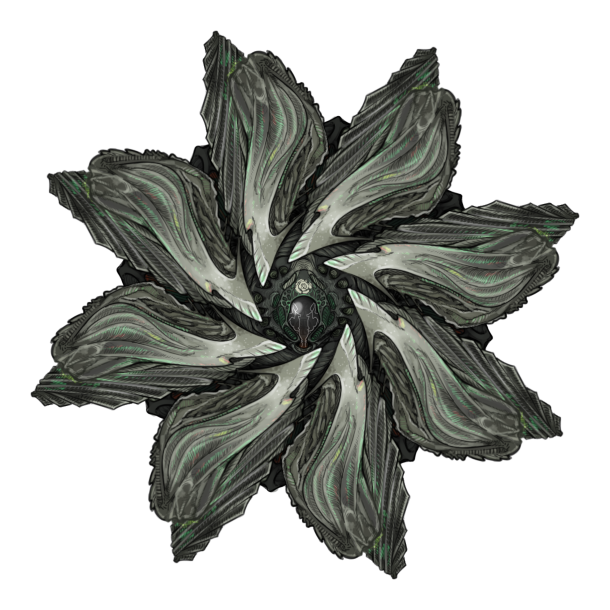 Weakest Variant of the Thargoid Interceptors, the cyclops variant is still a formidable foe. Presenting in a grey/cyan coloring, the cyclops interceptor has the most basic interceptor appearance and is also the most commonly found Interceptor. First actively encountered in 3303, Cyclops variants could be found crashed into various planets and would sometimes actively hyperdict pilots out of hyperspace.
Weakest Variant of the Thargoid Interceptors, the cyclops variant is still a formidable foe. Presenting in a grey/cyan coloring, the cyclops interceptor has the most basic interceptor appearance and is also the most commonly found Interceptor. First actively encountered in 3303, Cyclops variants could be found crashed into various planets and would sometimes actively hyperdict pilots out of hyperspace.
Cyclops variant interceptors are quick to kill and pose relatively little threat to a more experienced AX pilot, however they can still pack a punch albeit lesser than the other variants. The Cyclops variant is often considered the baseline Thargoid Variant of which other are often compared to.
On September 26, 3303 the Cyclops variant started indiscriminately attacking Independent ships along with Federal and Imperial navy vessels, where they could be found among wreckages of these ships in Non-Human Signal Sources collecting various Thargoid related items, such as the Thargoid Sensor and Thargoid Probe.
Hearts: 4
Max Speed: 450 m/s
Payout: 8,000,000 Cr
¶ Basilisk
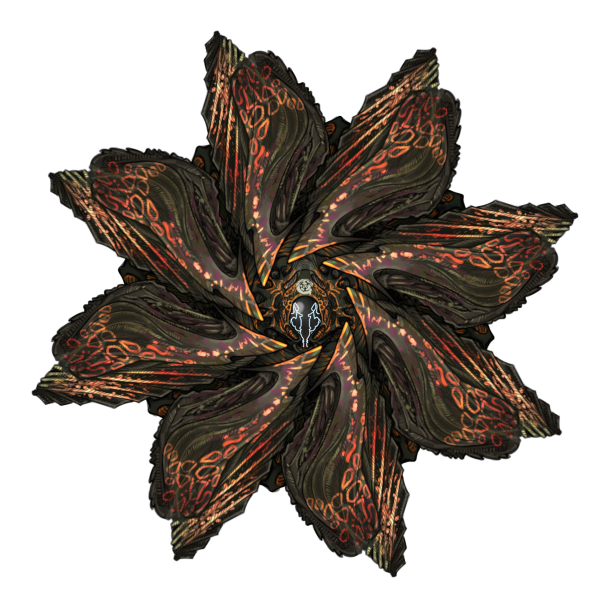 First encountered on November 13, 3303 The basilisk is a tougher variant of the Cyclops with a special trait, speed. The Basilisk is the only interceptor variant to have a higher maximum speed. This makes the basilisk a significant threat, especially to larger more cumbersome ships. Along with higher speed the Basilisk is also generally tougher, with one extra heart and a heavier hitting primary cannon.
First encountered on November 13, 3303 The basilisk is a tougher variant of the Cyclops with a special trait, speed. The Basilisk is the only interceptor variant to have a higher maximum speed. This makes the basilisk a significant threat, especially to larger more cumbersome ships. Along with higher speed the Basilisk is also generally tougher, with one extra heart and a heavier hitting primary cannon.
The Basilisk has a similar model to the Cyclops, with its distinguishing features being the darker red/brown tones and leopard print patterns on its petals.
Hearts: 5
Max Speed: 530 m/s
Payout: 24,000,000 Cr
¶ Medusa
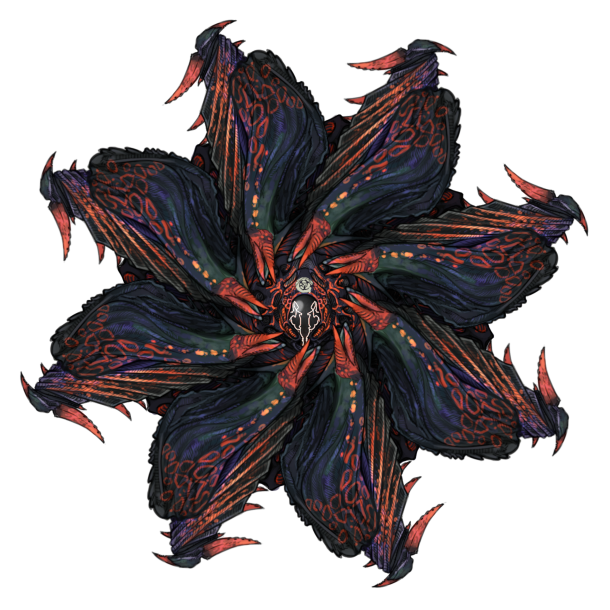 The Medusa variant was first witnessed on December 14, 3303 while attacking three stations. The Medusa is a greatly enhanced version of the Basiliks with much higher overall damage output and an extra heart. However the Medusa once again moves at the same speed as a Cyclops.
The Medusa variant was first witnessed on December 14, 3303 while attacking three stations. The Medusa is a greatly enhanced version of the Basiliks with much higher overall damage output and an extra heart. However the Medusa once again moves at the same speed as a Cyclops.
Not only is the Medusa a more vibrant red and black color, it also sports an array of sharp spine-like appendages that protrude from each petal and in-front of the canopy. This gives the Medusa variant a very menacing appearance.
Hearts: 6
Max Speed: 450 m/s
Payout: 40,000,000 Cr
¶ Hydra
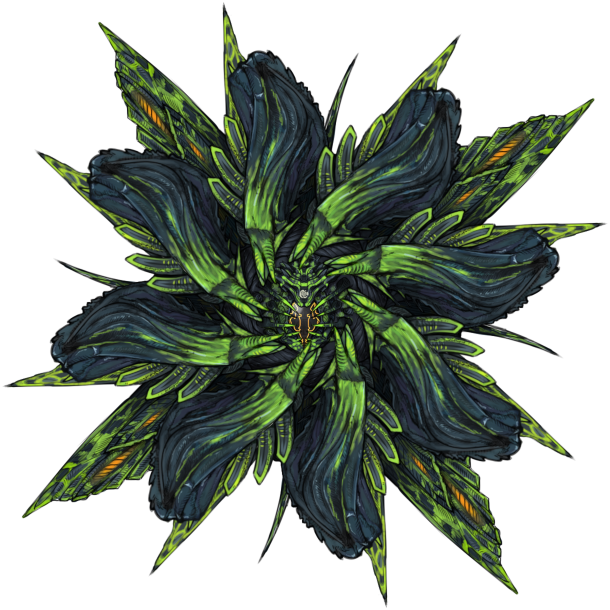 On August 23, 3304 the Hydra variant interceptor was first encountered. The Hydra variant is a significant step-up in power and toughness to the Medusa with an extra two hearts and overall higher armour toughness. The Hydra also exhibits a faster reload time which means it has a much more aggressive damage profile. The Hydra variant is currently the toughest Thargoid present and is a huge challenge to even the most experienced AX pilots.
On August 23, 3304 the Hydra variant interceptor was first encountered. The Hydra variant is a significant step-up in power and toughness to the Medusa with an extra two hearts and overall higher armour toughness. The Hydra also exhibits a faster reload time which means it has a much more aggressive damage profile. The Hydra variant is currently the toughest Thargoid present and is a huge challenge to even the most experienced AX pilots.
The Hydra variant exhibits bright green colors and a multitude of changes in its shape and form. The Hydra has another set of petals that sit behind the primary petals which actively obscure a pilot’s view of the hearts. The Hearts themselves are also different with spine appendages running along the counter-clockwise side of each petal. Furthermore the Hydra variant exhibits a different canopy layout with a cage covering the main canopy.
Hearts: 8
Max Speed: 450 m/s
Payout: 60,000,000 Cr
¶ Orthrus
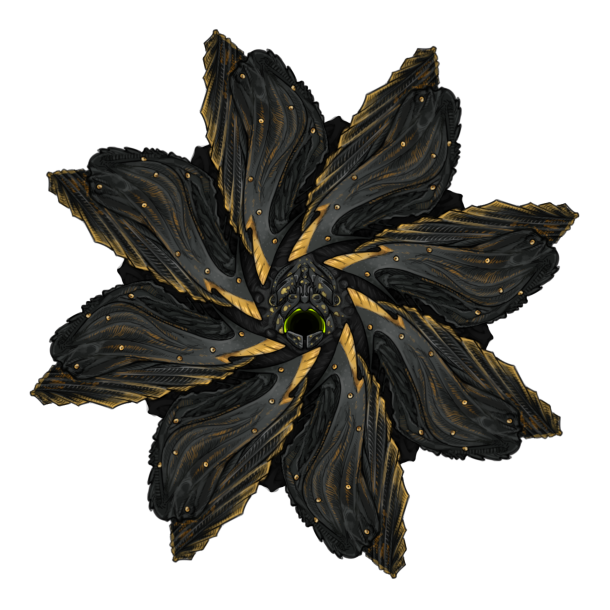 The fifth variant seen is the Orthrus, which temporarily appeared during the evacuation of Professor Palin from his research centre in Maia, and then remained unseen until the arrival of the Maelstroms.
The fifth variant seen is the Orthrus, which temporarily appeared during the evacuation of Professor Palin from his research centre in Maia, and then remained unseen until the arrival of the Maelstroms.
During its initial brief appearance, the Orthrus variant could be seen momentarily flying away from Palin’s Base before High-Waking away. At the time the Orthrus did not appear to have any combat mechanics and would glitch if destroyed. The Orthrus variant had similar stats to the Basilisk. When a sample was taken with the Research a “Basilisk Tissue sample” was received.
The Orthrus is speculated to fulfill a sort of intelligence and logistics role within the Thargoid fleet. It is spotted harvesting Thargoid Probes in NHSS Threat 4, they frequently travel between Spiresites and Titans and are seen enter and exit both structures. It has no hearts, and flees when attacked. However, it has a powerful shield and will employ an anti-guardian field while trying to flee. The Orthrus variant has disappeared together with the Titans and spire sites, for now.
Hearts: 0
Max Speed: 115 m/s
Payout: 15,000,000 Cr